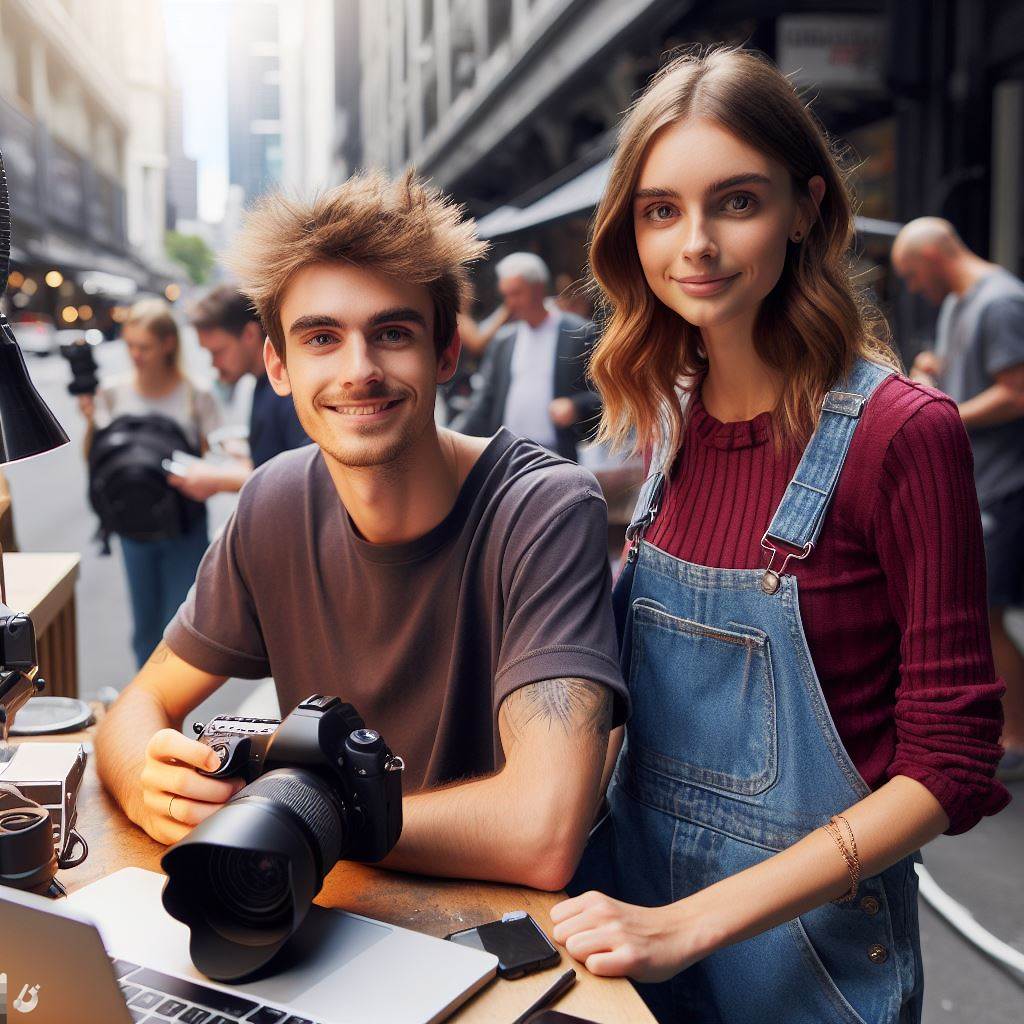Introduction
Street photography is a captivating art form that captures the essence of everyday life in Australia.
It involves candidly capturing people, places, and moments in public spaces, showcasing the spirit of the streets.
Street photography documents the diverse cultural landscape, the unique architecture, and the social dynamics of a city. By observing and photographing the streets, we can preserve and celebrate our collective heritage for future generations.
This genre of photography provides a window into the soul of a city and its people. It immortalizes fleeting moments, telling stories that might otherwise go unnoticed.
Street photography is not just a hobby; it is a powerful medium for self-expression and social commentary. Photographers have the ability to showcase societal issues, highlight beauty, and inspire change through their work.
The importance of street photography lies in its ability to document the present, to freeze moments in time. It captures the raw emotions and authentic narratives that define the character of a place.
Street photographers have the opportunity to shape the way we see and perceive the world around us Through their lens, they can challenge our preconceived notions, evoke empathy, and provoke thought.
In this guide, we will delve into the techniques, ethics, and challenges that come with street photography We will explore the unique Australian perspective and discuss the impact of this genre on our society.
Getting Started with Street Photography
Recommended cameras and lenses for street photography
- Fujifilm X100V: A compact and versatile camera with a fixed 23mm lens, ideal for street photography.
- Sony a7 III: A full-frame mirrorless camera that offers excellent image quality and low-light performance.
- Canon Rebel T7i: A budget-friendly DSLR with a variety of lens options, perfect for beginners.
- Olympus OM-D E-M10 Mark III: A micro four-thirds camera that combines portability and high image quality.
- Leica Q2: A premium compact camera with a fast lens and excellent low-light capabilities.
Tips on choosing the right equipment
- Consider the size and weight of the camera: Street photography often requires being inconspicuous, so compact and lightweight options are preferable.
- Look for fast and wide lenses: Wide-angle lenses allow you to capture the whole scene, while lenses with wide apertures enable better low-light photography.
- Consider the camera’s autofocus capabilities: Street photography requires quick and accurate autofocus to capture fleeting moments.
- Keep in mind the camera’s ISO performance: High ISO capabilities are crucial for shooting in low-light conditions without compromising image quality.
- Choose a camera with good ergonomics: Make sure the camera feels comfortable and easy to handle for long periods.
Understanding exposure and settings for street photography
- Aperture: Use a wide aperture (low f-number) to separate your subject from the background and create a shallow depth of field.
- Shutter speed: Set a fast shutter speed to freeze motion and capture sharp images, especially when photographing moving subjects.
- ISO: Adjust the ISO based on the available light. Increase it in low-light situations, but be cautious of noise in high ISO settings.
- Metering mode: Evaluative or matrix metering works well in most situations, but spot metering can be useful in high-contrast scenes.
- Shooting mode: Utilize aperture priority mode to control the depth of field or manual mode for complete exposure control.
Additional Tips for Getting Started with Street Photography
- Explore your surroundings: Walk around different areas, observe people’s interactions, and find interesting compositions.
- Be discreet: Blend in with the crowd, dress inconspicuously, and avoid drawing unnecessary attention to yourself.
- Capture emotions and storytelling: Look for candid moments that convey emotions and tell a story about the streets and its people.
- Pay attention to light and shadows: Utilize natural light creatively, and embrace shadows to add depth and drama to your images.
- Practice patience: Street photography often requires waiting for the right moment or the perfect subject, so be patient and persistent.
Remember, street photography is about capturing spontaneous moments and showcasing the essence of everyday life.
With the right equipment, understanding exposure settings, and a keen eye, you’ll be well on your way to capturing stunning street photographs in Australia.
Finding the Right Locations
When it comes to street photography in Australia, finding the right locations is crucial. Here are some tips to help you in your quest:
Researching and Identifying Potential Locations
Before heading out with your camera, it’s essential to do some research to identify potential locations for street photography in Australia.
- Make use of online resources.
- Join photography forums and communities to get recommendations from local photographers.
- Check out social media platforms like Instagram to see popular street photography spots.
- Read travel blogs that focus on street photography in Australia for inspiration.
- Don’t forget to study maps and city guides to familiarize yourself with different areas.
Popular Cities and Neighborhoods
Australia is home to several cities and neighborhoods that offer excellent opportunities for capturing street scenes.
- Sydney: Known for its bustling streets, iconic landmarks, and diverse street culture.
- Melbourne: Famous for its laneways, street art, and vibrant atmosphere.
- Brisbane: Offers a mix of modern architecture, riverside scenes, and urban street life.
- Adelaide: Known for its charming lanes, colorful festivals, and cultural diversity.
- Perth: Features stunning coastal locations, shopping precincts, and vibrant street scenes.
Exploring the Diversity of Australian Street Culture
One of the most exciting aspects of street photography in Australia is the diversity of street culture you’ll encounter.
- Indigenous Culture: Indigenous neighborhoods offer a unique insight into Australia’s rich history.
- Multiculturalism: Capture the vibrant diversity of cultures in cities like Melbourne and Sydney.
- Urban Scenes: High-rise buildings, bustling streets, and city life abound in Australia’s urban centers.
- Coastal Charm: Head to coastal cities like Perth and Sydney for beachside street scenes.
- Rural Australia: Explore small towns and rural areas to capture the essence of Australian country life.
Remember, finding the right locations for street photography in Australia is an ongoing process. As you explore, be open to new discoveries and unexpected moments. Happy shooting!
Read: The Evolution of Australian Music Genres
Capturing the Moment: Tips for Candid Street Photography
Street photography is all about capturing authentic moments and genuine emotions. Here are some tips to help you master the art of candid street photography:
1. Be inconspicuous
Blend into your surroundings and avoid drawing attention to yourself. This will help you capture candid moments without altering the natural behavior of your subjects.
2. Use a prime lens
A prime lens with a wide aperture allows you to shoot in low light conditions and gives a beautiful shallow depth of field, adding more emphasis to your subject.
3. Shoot from the hip
Experiment with shooting from waist level or holding your camera at different angles to capture unique and unexpected perspectives.
4. Stay patient
Observe your surroundings and wait for the right moment to press the shutter. Patience is key when it comes to capturing the perfect candid shot.
5. Anticipate action
Learn to predict the next move of your subjects. By being aware of your environment, you can capture fleeting moments of action and emotion.
6. Use burst mode
When shooting moving subjects, such as street performers or bustling city streets, activate the burst mode to increase your chances of capturing the perfect moment.
Your Personalized Career Strategy
Unlock your potential with tailored career consulting. Get clear, actionable steps designed for your success. Start now!
Get Started7. Pay attention to light and shadows
Shadows can add depth and drama to your photographs. Look for interesting light patterns and use them to enhance the mood of your street images.
8. Include human elements
Incorporate people into your composition to add a sense of scale and storytelling to your street photographs. People bring life to the streets.
9. Seek out contrasting colors
Vibrant or contrasting colors can make your subject stand out and create visually dynamic street photographs.
10. Frame within a frame
Look for natural frames within your surroundings, such as windows, doorways, or arches. These frames can add depth and focus to your images.
11. Capture emotions
Street photography is all about capturing emotions. Look for candid moments that evoke a strong emotional response, whether it’s joy, surprise, or contemplation.
12. Experiment with different angles
Try shooting from various angles, high or low, to add a fresh perspective to your street images. Don’t be afraid to get down on the ground or climb up for a different vantage point.
13. Keep your camera settings ready
Streets are fast-paced environments, and opportunities can arise and disappear in seconds. Make sure your camera settings are dialed in and ready to go at all times.
14. Embrace imperfections
Street photography thrives on the raw and unpolished. Don’t be afraid of capturing imperfect moments; they often tell the most authentic stories.
15. Practice observation
The more you practice street photography, the better you’ll become at observing and anticipating moments. Train your eye to see smaller details and patterns within the chaos of the streets.
Remember, capturing the moment in street photography requires patience, observation, and an understanding of how to blend into your surroundings.
So grab your camera, hit the streets, and embrace the unpredictable beauty that unfolds before your lens.
Read: Building a Music Career in Australia
Dealing with Legal and Ethical Issues in Street Photography
Understanding the laws and regulations surrounding street photography in Australia
- Familiarize yourself with the relevant laws and regulations governing street photography in Australia.
- Research specific restrictions, permits, or areas where street photography may be prohibited in certain locations.
- Stay up to date with any changes or updates in the legal landscape regarding street photography.
- Ensure you understand and comply with copyright laws by respecting the intellectual property of others.
- Avoid photographing sensitive sites such as government buildings or military installations.
Tips for obtaining consent and respecting privacy
- Obtain consent whenever possible, especially if you plan to publish or publicly share the photographs.”
- If you are photographing children or vulnerable individuals, seek parental or guardian permission.
- Respect people’s privacy by refraining from taking intrusive or compromising photographs without their consent.
- If someone asks you not to photograph them, kindly comply and respect their wishes.
- Consider blurring or obscuring faces or identifiable features of individuals to preserve their anonymity.
Ethics and considerations when photographing strangers in public spaces
- Be aware of local customs and cultural sensitivities when photographing individuals from different backgrounds.
- Exercise empathy and refrain from exploiting or misrepresenting people through your photographs.
- Avoid capturing or sharing images that may be offensive, disrespectful, or degrading to individuals or communities.
- Take the time to build rapport and establish a connection with your subjects before photographing them.
- Consider the impact your photographs may have on your subjects and the wider community.
“Navigating Ethics and Laws: Responsible Street Photography Practices in Australia”
Street photography can be a powerful medium for capturing the essence of everyday life in public spaces. However, it is essential to navigate the legal and ethical aspects of this art form responsibly.
Understanding the laws and regulations surrounding street photography is crucial to ensure you stay within legal boundaries.
Familiarize yourself with Australia’s specific restrictions and permits required in certain locations. Stay updated with any changes in the legal landscape to avoid legal complications.
“Ethical Guidelines in Street Photography: Respecting Privacy and Seeking Consent for Authentic Representation”
Respecting privacy is fundamental when engaging in street photography. Obtaining consent whenever possible is highly advisable, especially if you plan to share the photographs publicly.
Be particularly cautious when photographing children or vulnerable individuals, seeking the appropriate permissions from their parents or guardians.
Stand Out with a Resume That Gets Results
Your career is worth more than a generic template. Let us craft a resume and cover letter that showcase your unique strengths and help you secure that dream job.
Get HiredIt is crucial to exercise ethics and sensitivity when photographing strangers in public spaces.
Be mindful of cultural sensitivities and customs, treating your subjects with respect and empathy. Avoid exploiting or misrepresenting individuals through your photographs.
Additionally, respecting the dignity and privacy of your subjects is paramount. If someone requests not to be photographed, kindly comply and respect their wishes.
Consider blurring or obscuring faces and identifiable features of individuals to protect their anonymity.
“Fostering Connections and Ethical Practices: Guidelines for Responsible Street Photography in Australia”
Building rapport with your subjects and establishing a connection before capturing their photographs is vital. This not only helps create a more genuine representation but also demonstrates a form of acknowledgment and respect towards them.
As a responsible street photographer, be cautious of the impact your photographs may have on your subjects and the wider community. Avoid capturing or sharing images that may be offensive, disrespectful, or degrading.
In essence, understanding the legal and ethical considerations surrounding street photography in Australia is crucial.
By adhering to the laws and regulations, obtaining consent, respecting privacy, and practicing ethical photography, we can engage in this art form responsibly and create meaningful and impactful images.
Read: How to Network in Australia’s Music Scene

Editing and Post-Processing
Editing and post-processing are essential steps in street photography. They allow you to enhance and refine your street photographs while preserving the authenticity and integrity of the captured moments.
Here are some recommended software and tools for editing street photographs:
Recommended Software and Tools
- Adobe Lightroom: Lightroom is a popular choice among photographers for its comprehensive editing and organizing features.
- Adobe Photoshop: Photoshop offers advanced editing capabilities, allowing you to fine-tune your images and remove distractions.
- Capture One: Capture One is known for its exceptional color grading and tethered shooting capabilities, making it a favorite among professionals.
- Nik Collection: Nik Collection is a set of powerful plugins that can be used with Lightroom, Photoshop, or Capture One to enhance your street photographs.
Techniques to Enhance and Refine
Once you have chosen the right software, you can apply various techniques to enhance and refine your street photographs:
- Adjust Exposure: Use exposure adjustments to balance the highlights and shadows, ensuring proper lighting in your images.
- Crop and Straighten: Crop your photos to remove distractions and straighten them to create a more pleasing composition.
- Enhance Colors: Adjust the saturation and vibrance to make colors pop, but be careful not to overdo it, maintaining a natural look.
- Sharpen Details: Apply selective sharpening techniques to bring out the fine details in your street photographs.
- Remove Distractions: Clone stamp, heal brush, or content-aware fill tools can help you remove distractions like stray objects or people.
- Apply Film Effects: Experiment with film presets or create your own to give your street photographs a unique, timeless feel.
Preserving Authenticity and Integrity
While editing and post-processing can significantly enhance your street photographs, it’s crucial to preserve their authenticity and integrity. Here’s how:
- Limit Alterations: Avoid excessive alterations that can change the essence of the moment or misrepresent the reality.
- Maintain Natural Feel: Strive for a natural look in your edits, ensuring that the final result reflects the original scene.
- Avoid Heavy Filters: Be cautious while using filters, as they can easily overpower the image and detract from its authenticity.
- Retain Imperfections: Embrace the imperfections that make street photography unique, preserving the rawness of the captured moments.
- Stay True to the Story: Ensure that your editing choices align with the story you aimed to tell through your street photographs.
Remember, editing and post-processing should enhance your street photographs without compromising their authenticity.
With the right software, techniques, and a conscious effort to preserve the integrity of the captured moments, you can elevate your street photography while staying true to its essence.
Read: Music Production: A Guide for Aussies
Sharing and Showcasing Your Work
When it comes to street photography, sharing and showcasing your work is crucial. It allows you to connect with other photographers, gain feedback, and improve your skills.
Here are some platforms and communities you can use, as well as tips for building an online presence:
Platforms and Communities for Sharing
- Instagram: One of the most popular platforms for sharing street photographs online, allowing you to reach a large audience.
- Flickr: A community of photographers where you can share your work and engage with other street photography enthusiasts.
- 500px: A platform known for its high-quality images and active community, perfect for showcasing your street photography skills.
- EyeEm: An app and community that focuses on discovering and connecting with other photographers, including street photographers.
- Street Photography Subreddits: Reddit has various subreddits dedicated to street photography, such as r/StreetPhotography and r/UrbanExploration.
Building an Online Presence
- Create a Website: Having your own website allows you to showcase your work in a personalized and professional manner.
- Start a Blog: Share stories and insights behind your street photographs, attracting readers and fellow photographers.
- Engage on Social Media: Regularly post your street photography on platforms like Facebook and Twitter to gain exposure and connect with others.
- Join Online Communities: Participate in forums, groups, and online communities focused on street photography to network and learn from others.
- Collaborate with Other Photographers: Team up with other street photographers to create projects or exhibitions, expanding your audience and connections.
Seeking Feedback and Constructive Criticism
- Join Critique Groups: Find or create a critique group where you can share your work and receive constructive feedback from fellow photographers.
- Attend Workshops and Photowalks: Participating in these events allows you to connect with experienced photographers and learn from their expertise.
- Ask for Feedback Online: Post your street photographs in communities or forums and ask for feedback to gain different perspectives on your work.
- Be Open to Criticism: Embrace constructive criticism as an opportunity to grow and improve your skills, rather than taking it personally.
- Experiment and Learn from Others: Study the work of established street photographers and incorporate their techniques into your own style.
Remember, sharing and showcasing your street photography is an ongoing process. Continuously strive to improve your skills, connect with other photographers, and seek feedback.
Utilize online platforms, communities, and offline events to build a strong online presence and enhance your street photography journey.
You Might Also Like: Artists in Australia: Navigating Gallery Contracts
Transform Your LinkedIn for Maximum Impact
Elevate your professional brand with a LinkedIn profile that attracts recruiters, showcases your expertise, and maximizes opportunities. Stand out in your industry with a profile built for success.
Boost ProfileDiscover More: Art Disputes in AU: Legal Solutions for Artists
Conclusion
Summarizing the guide: We traversed the essentials of street photography for Australians, touching on gear choices, techniques, and the ethical nuances that define this art form, creating a comprehensive roadmap for both novice and seasoned photographers.
Encouragement: To our Australian readers, take that first step onto the streets! Dive into the dynamic scenes, explore the nooks and crannies of your cities, towns, and neighborhoods.
Street photography in Australia is an invitation to capture the diverse stories unfolding around you.
Inspiration: Beyond just a hobby, street photography is a profound creative journey.
It’s a medium that can transform the way you see and experience the world, providing fulfillment and potential career opportunities.
Embrace the art, for the streets are filled with moments waiting to be captured and shared.
Happy shooting!




